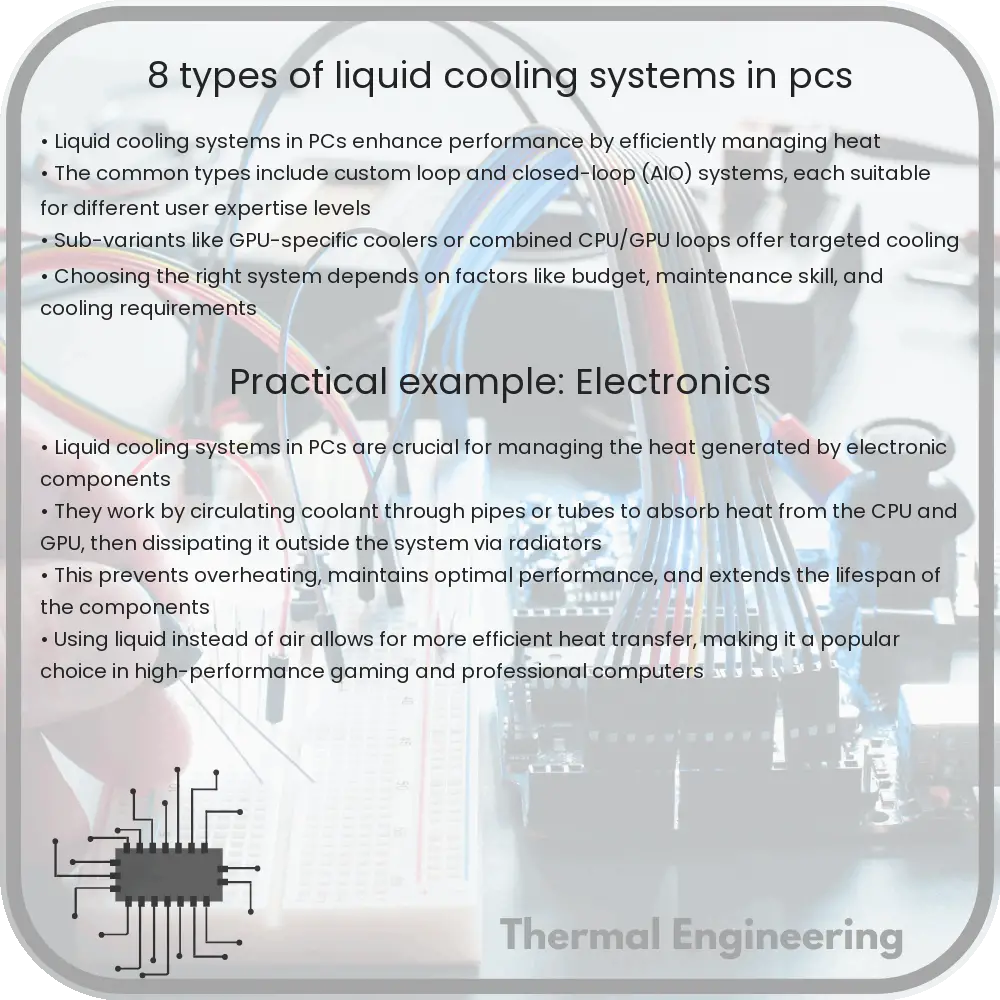Learn about liquid cooling systems in PCs, which improve component longevity and performance by efficiently managing heat.

Introduction to Liquid Cooling Systems in PCs
Liquid cooling systems in personal computers (PCs) are used to more efficiently remove excess heat from components, notably the central processing unit (CPU) and the graphics processing unit (GPU). These systems use a liquid coolant which absorbs heat from the components and transfers it away, typically to a radiator. Compared to traditional air cooling, liquid cooling is generally more efficient at heat management, leading to better performance and longevity of the PC components.
Types of Liquid Cooling Systems
There are various types of liquid cooling systems available, each with its own unique features and mechanisms for cooling PC components. Here’s a detailed look at eight common types:
- All-in-One (AIO) Coolers: These are pre-assembled and sealed systems that require minimal setup. AIO coolers combine a pump, radiator, and cooling block in a single unit, making them user-friendly and maintenance-free compared to more complex setups.
- Custom Loop Cooling Systems: Designed for enthusiasts, these systems allow for complete customization and optimization. They often consist of separate components that users can select based on their cooling needs, including various sizes of radiators, different types of pumps, and reservoirs.
- Closed-loop Coolers: Similar to AIO coolers but often focused on single component cooling. These systems are sealed and don’t require refills, making them convenient and reasonably efficient.
- Open-loop Coolers: These provide the opportunity to expand and customize the cooling system. Unlike closed-loop coolers, open-loop systems are not sealed, allowing the addition or replacement of components such as additional radiators or cooling blocks for other components like GPUs.
- GPU Liquid Coolers: Specifically designed to cool graphics cards, these coolers can be found as both AIO and custom setup options. GPU coolers are crucial for gamers and professionals who require maximum performance from their graphics components.
- Integrated Liquid Cooling (ILC): These systems integrate liquid cooling directly into the PC’s hardware components, providing efficient direct-contact heat transfer. Though not as common, they offer an innovative approach to handling high heat loads in compact spaces.
- Passive Liquid Cooling: This type utilizes the natural convection of heat without the need for additional power-consuming components like pumps or fans. These systems are quieter but generally less effective at heat management under heavy load conditions.
- Hybrid Coolers: Combining elements of both air and liquid cooling, hybrid coolers use liquid to cool specific high-temperature components while still employing fans to assist with the overall airflow within the chassis. This can offer a balance between efficiency and complexity.
Choosing the Right Liquid Cooling System
When selecting a liquid cooling system, it is crucial to consider factors such as the specific cooling needs of your PC components, your budget, and the level of maintenance you’re willing to undertake. Beginners might find all-in-one coolers to be an excellent starting point, while experienced users may prefer the customization offered by custom loop systems.
Conclusion
Liquid cooling systems offer a superior solution to heat management in PCs, catering to a range of needs from basic cooling to high-performance, overclocked setups. Understanding the types of liquid cooling systems available helps in making an informed decision, ensuring optimal performance and durability of your PC components.